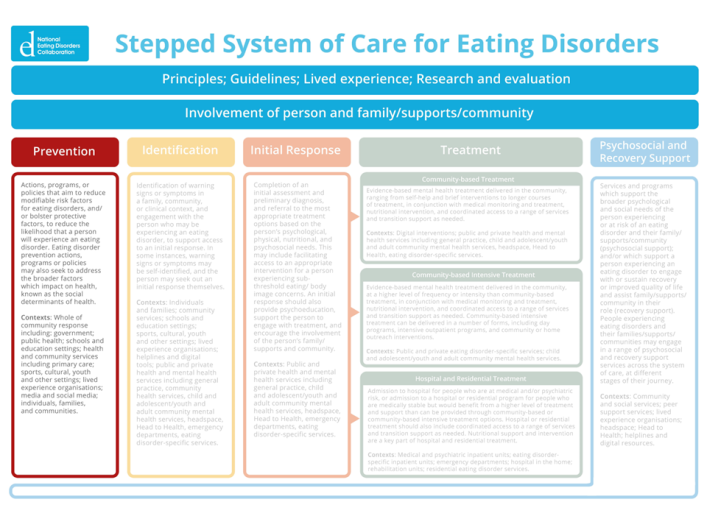Eating disorder prevention refers to actions, programs, or policies that aim to reduce modifiable risk factors for eating disorders, and/or bolster protective factors, to reduce the likelihood that a person will experience an eating disorder. Eating disorder prevention actions, programs or policies may also seek to address the broader factors which impact on health, known as the social determinants of health.
Prevention initiatives may be directed towards a general population group regardless of their risk factor status (universal prevention), towards specific sub-groups of the population at higher-than-average risk of eating disorders (selective prevention), or towards individuals who are experiencing sub-threshold signs or symptoms of an eating disorder (indicated prevention) (1).
Effective eating disorder prevention can stop people from developing eating disorders and their
associated, potentially long-term, mental and physical health consequences (2). As well as reducing the burden on individuals, families and communities, eating disorder prevention can reduce pressure on the health care system (3). Further, eating disorder prevention activities can help to promote wider mental and physical health.
To date, the modifiable risk factors that have been the main targets for eating disorder prevention research and program implementation include sociocultural appearance pressures, body dissatisfaction, especially weight and shape concerns, and appearance change behaviours such as dieting and excessive exercise (2). Further information about prevention programs can be found here.
The importance of addressing the wider social and environmental factors which impact on eating disorder risk is being increasingly recognised, requiring macro-level policy responses (4, 5). One key social and environmental factor which has been highlighted in the literature as an important focus for eating disorder prevention is weight stigma (6). You can read more about weight stigma here.
We encourage you to read the Prevention section in the National Strategy for further information about areas of focus in prevention, as well as standards and actions for building this element of the system of care. Please see pages 36-40.

Click to read more about the Stepped System of Care.
References
1. Institute of Medicine. Reducing risks for mental disorders: Frontiers for preventive intervention research: The National Academies Press; 1994.
2. Stice E, Onipede ZA, Marti CN. A meta-analytic review of trials that tested whether eating disorder prevention programs prevent eating disorder onset. Clin Psychol Rev. 2021 Jul;87:102046.
3. Moessner M, Bauer S. Maximizing the public health impact of eating disorder services: A simulation study. Int J Eat Disord. 2017 Dec;50(12):1378-84.
4. Austin SB. A public health approach to eating disorders prevention: It’s time for public health professionals to take a seat at the table. BMC Public Health. 2012 Oct 9;12:854.
5. Austin SB. Accelerating progress in eating disorders prevention: A call for policy translation research and training. Eat Disord. 2016;24(1):6-19.
6. Hart L, Ferreira K, Ambwani S, Gibson E, Austin S. A roadmap for addressing weight stigma in public health research, policy, and practice. [Internet]. 2020 [cited 2023 Jul 3]. Available from: https://www.hsph.harvard.edu/striped/striped-roadmap-for-addressing-weight-stigma-in-public-healthresearchpolicy-and-practice/.

